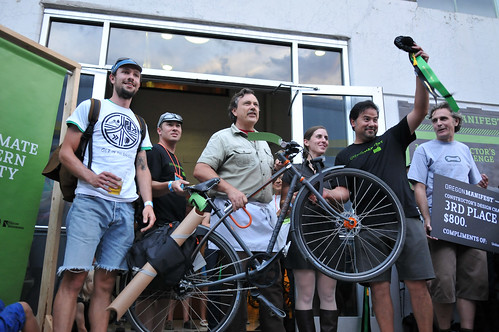 |
| image via Jonathan Maus/ BikePortland.org |
The Oregon Manifest took place over last weekend, and it was fascinating to follow. Having now become an annual tradition, this event is a competition among framebuilders - a "constructor's design challenge" - for creating the ultimate utility bike. What's a utility bike? You are not the only one who's wondering. Not only does everyone seem to have a different idea of the meaning of this concept, but the Manifest's parameters have shifted over time as well.
 |
| image via scurvy_knaves |
In the first couple of years of the competition, most of the participating framebuilders submitted some version of modified racing bikes or French
randonneur or
porterur inspired bicycles: aggressive diamond frame bikes designed to carry a front load (I believe the requirement was a case of beer). Only some of the entries were equipped with proper lights, fenders and other basics. This approach was criticised for taking into account the needs and abilities of only a small portion of cyclists, and for not being sufficiently condusive to everyday use.
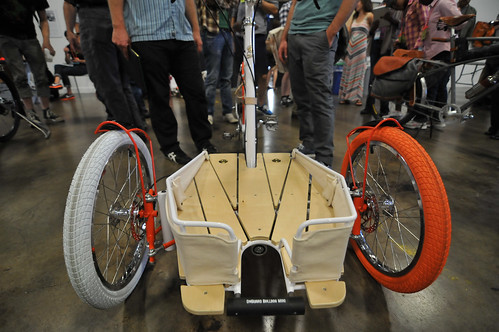 |
| image via Jonathan Maus/ BikePortland.org |
But the entries were radically different. Nearly all framebuilders submitted some version of a cargo bicycle - ranging from contemporary versions of long-tails, to long johns, to front load box bikes and tricycles resembling small houseboats. Electric assist was used on what seemed like half of them. Mixte or step-through designs on some.
 |
| image via Jonathan Maus/ BikePortland.org |
With this in mind, it is somewhat ironic that this year's competition seems to have garnered even more criticism than I recall in previous years - and mostly from transportation cyclists. All weekend long there was exchange about it on
twitter that has been summarised in this post by Dave Feucht on
Portlandize - the gist of it being that the winning entries suffer from lack of real-world applicability, making the Oregon Manifest "irrelevant." Personally, I would not go that far.But - with the disclaimer that I did not actually attend the show and formed impressions based on photographic evidence - my personal view is that this year's competition went too far into the opposite direction from which it started.
 |
| image via Jonathan Maus/ BikePortland.org |
Most of the designs I see in the show's documentation are so convoluted that I hardly know where to look, let alone how to operate the bikes. From side-cars, to bags suspended like hammocks, to complicated locking systems, to frames that look like they are designed for an acrobat, it seems to me that many framebuilders focused on bells and whistles rather than actual utility. It also seems like many of the builders worked in a vacuum - trying to design a cargo bike from scratch instead of taking into consideration the perfectly good, time-tested models that have been out there for decades.
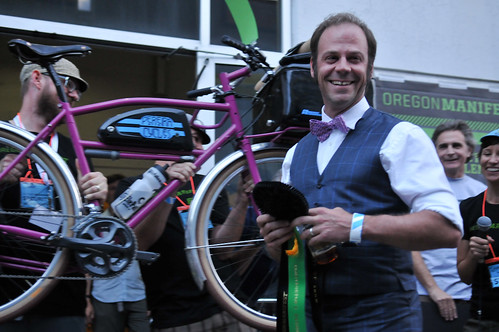 |
| image via Jonathan Maus/ BikePortland.org |
I suspect the judges felt this as well - because the winning entry was fairly simple in comparison to the others. But I agree with
Portlandize that an integrated stereo and carbon fiber lock box for your lunch do not make a bicycle a "car replacement."
 |
| image via Jonathan Maus/ BikePortland.org |
There were a few bicycles in the show that - to my eye - were both simple and utilitarian, such as the Quixote/CleverCycles collaboration, the Rock Lobster bike, and the entry from Geekhouse. And my personal favourite in the show was the long tail + front loader by Retrotec/Inglis Cycles (above). The low step-through makes it accessible to everyone, regardless of gender and choice of clothing. The X-tracycle-based design and extra boards placed low in the rear allow for enormous loads as well as passengers, and the front utility rack allows for more cargo still. The design is harmonious and classic and the bicycle looks approachable to a moderately skilled cyclist - which I think is an important factor many builders tend to undermine.
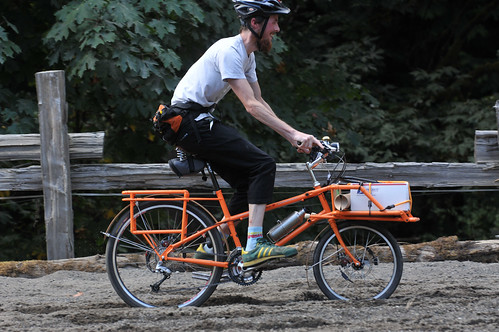 |
| image via Jonathan Maus / BikePortland.org |
Finally, I agree with the comment on
Portlandize that the Field Test part of the challenge - a 50 mile on and off road course over a mountain - is not representative of how a typical person in North America would wish to use a heavy-duty utility bike. It was a relevant test when the
randonneurstyle bicycles were prevalent among the entries, but not for bikes like these - the whole point of which is to carry much more than is pictured, but over shorter distances.With all the talk of "car replacement" in the guidelines, a huge cargo-style family bike seems to not have been what the organisers of the Oregon Manifest had in mind.
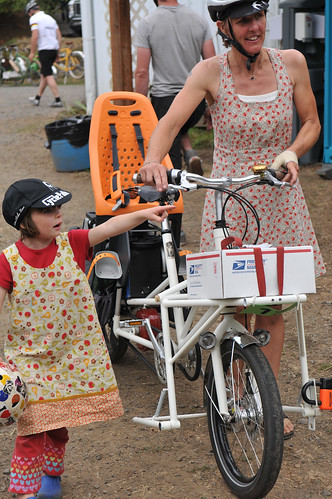 |
| image via Jonathan Maus/ BikePortland.org |
There are many varieties of utility bikes out there and perhaps events such this would do better if they picked one and stuck to it, optimising all the aspects of the competition - including the field test - for testing that particular style of bicycle. There is a world of difference between
randonneuring bicycles and long-johns, and a competition that is vague enough to include both - and then make them race against one another - is bound to evoke criticism.
"Identity before destiny" might be a motto to consider for next year's
Oregon Manifest. And one could say that the same issue faces the utility bike market in North America at large. What do we mean by "car replacement?" Are stereos and electric assist must-have parts of the equation, or is it about ease of operation and hauling capacity? And is it reasonable to expect such a bicycle to win a 50 mile race?









No comments:
Post a Comment